(Afghan Hound Database and Breed Information Exchange)
|
|
|
"ZARDIN"
(By Steve Tillotson 2013, updated 2014, 2015. 2016)
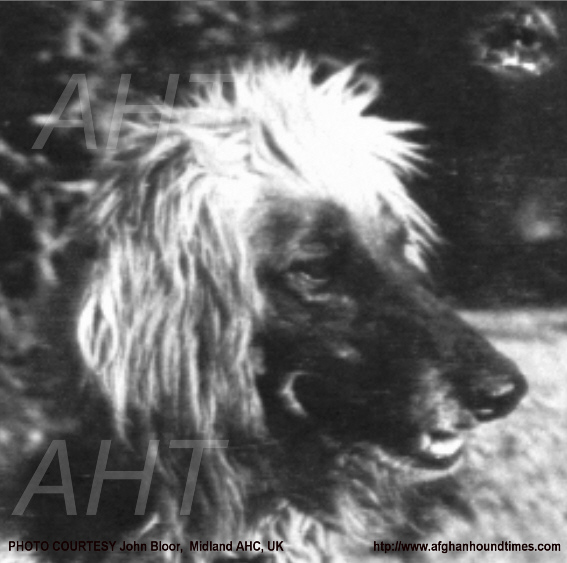 |
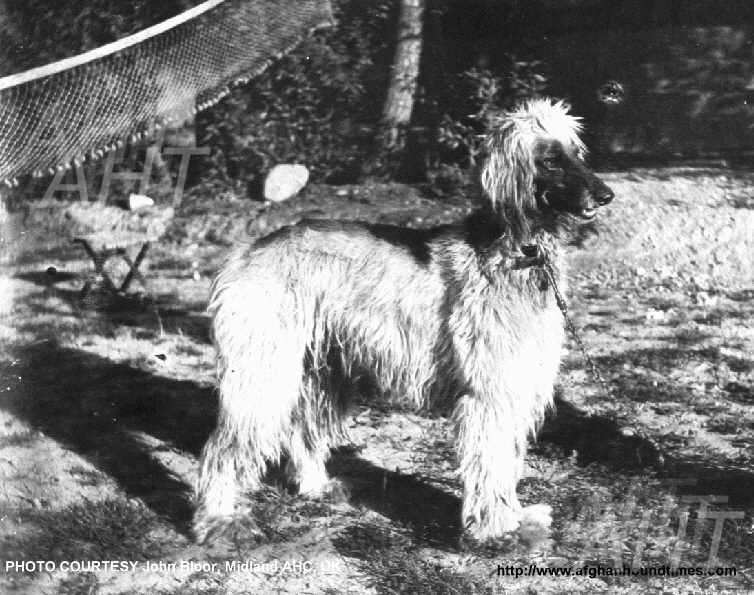
ZARDIN - TIMELINE
Zardin 1902-1907
Zardin was reportedly born in 1902 in Seistan Province in the then Persia (Now Iran) which borders Afghanistan. Zardin was exhibited in Quetta (Originally in Baluchistan, British India. Quetta is now part of Pakistan). The Indian Kennel Club (IKC) provided a description of Zardin written in 1906. This description is the basis of the UK Afghan Hound Breed Standard.
Zardin 1907-1908
It is reputed that Zardin was presented to Queen Alexandra at Buckingham Palace, we found a press item that confirms this to be true.
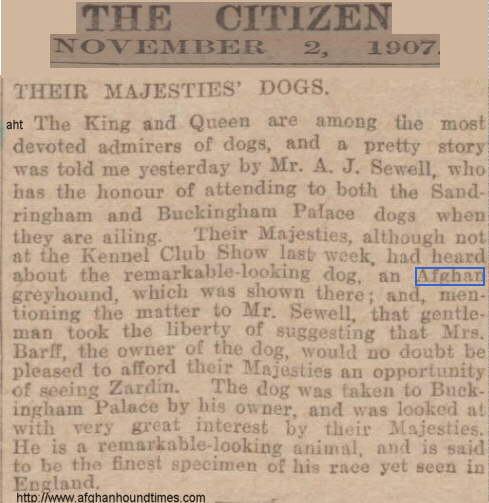 |
ZARDIN 1909-1911
Zardin won the Foreign Dog class at Crufts in 1909, 1910 and 1911. Classes for "Afghan Hounds" were not scheduled at Crufts until 1925, so Zardin was entered in the "Foreign Dogs" classes. Zardin is important because he was the model for the early Afghan Hound Breed standard. Later, Zardin was sold to a dog dealer, Mr Shackleton, who had a dog dealer business located in London's Leadenhall Market (Leadenhall Market still exists today). Zardin produced some offspring from two littes he sired, but none of his proginey appear in any Afghan Hound pedigrees anywhere in the world.
Show catalogue listings for Zardin (see below) reveal the changes of ownership as mentioned above:

- Summary Of Zardin's Owners
- 1909 Owner Mr J Barff but transferred to
Mr Shackleton by July 1909, see update below - 1910 Owner Mr S Shackleton
- 1911 Owner A Shackleton
UPDATE 7/15/15
1. RECENTLY DISCOVERED PRESS ARTICLES
1.1 Referee (Sydney, NSW) Page 4, Wednesday 18 December 1907
The Afghan Greyhound.
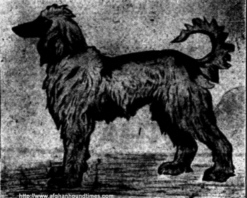 |
English admirers of Oriental dogs have imported specimens from time to time, and, in spite of the quarantine which has been necessary for the past few years, most of them have been benched at the leading shows (says the London 'Field'). The appearance of all of them has aroused curiosity, but no forefgn dog, not excepting the Dogue do Bordeaux, a specimen of which created anything, but a mild diversion when he made his last appearance in public at one of the Aquarium shows, has attracted so big a crowd to his bench, as is the case with Mrs. M. C. Barff's Zardin, an Afghan greyhound, at the Crystal Palace. He was fairly mobbed, and in the circumstances he behaved especially well, though, naturally, he appeared to be surprised that he should attract, so much attention,- and he was obviously uneasy when his attendant was not in sight. Afghan Bob, another specimen of the variety, was shown for the second year in succession; but he does not possess the dignity and grace of Zardin, whom authorities declare to be the best Oriental greyhound yet seen in England. Nearly twenty years ago Mr. Wardle illustrated an article by Mr. Tegutmeier on Asiatic hounds, a Rampur, or greyhound of Northern India, and an Afghan, Shahzada by name, being' described, "Up to that time Shahzuda was the most typical specimen of the breed seen in Europe, for, being owned by native, chiefs, it is difficult to secure really good specimens". Shahzada was owned by Mr. Whitbread, and at his death the skin was, contributed to the Natural History Museum, South Kensington, where it was set up, and now forms one of the most treasured charges of the curator. Shahzada was a, fine, upstanding hound, reddish-fawn, almost wheaten in- color. The head was, of the same type, but the body was covered with a profusion of soft golden-colored hair extending over the ears. shoulders, and half way down the legs, the lower half being bare of the long hair, but the sides were heavily feathered. The skull, by the way. was quite smooth. Zardln the subject of the present illustration above (by Mr. Wardle). differs from Mr Whltbread's fine hound in carrying a much greater profusion of coat, and in being creamy rather than golden or reddish-fawn in color. The body covering is carried down the legs, and Zardin also has a peculiar tuft of hair on the skull, which otherwise is, quite 'smooth, as in the case of Shahzada. Mrs. Barff's hound stands at least 26in. at the shoulder, and he was brought from Seistan, in Afghanistan, to Quetta, where he was shown with success before being imported to England. At Quetta he was said to be the finest speclman of the breed over seen out of his native country. Nothing Is known about hls pedigree or his breeder, but Mrs. Barff believes him to be five years old. In some respects the Afghan resembles the Persian greyhound, the last named how ever, not being so shaggy and corded in appearance at; the hound which was one of the most interesting exhibits at the fifty-second show of the Kennel Club
1.2 The Australasian (Melbourne, Vic), Page 14, Saturday 11 January 1908
Great interest. was also taken in the appearance of the Afghan greyhound Zardin, although he was 'not for competition.' Mrs. Barff, his owner, Is obliged to return to India, and is anxious to sell Zardin, but the price that is heing asked for him (£300) seems to be far above his value, excepting to the lover of the foreign dogs, who wished to own a rarity and an animal which has been described by Indian authorities as the best one seen even in his native country. That the breed has gained admirers since Zardin was shown at the Crystal Palace is proved bv the demand for puppies which has arisen, and Mrs. Barff has several already on order to be delivered in London after import and quarantine, at, prices ranging from £50 to £75. Such prices for stock which has not been seen, although offered according to 'sample,' are astonishing, for one could buy many really passable English dogs for the price which is being asked for one of the latest foreigners to be imported, although in the case of the last named a considerable amount must be added for freight and maintenance during quarantine."
1.3 Lincolnshire Echo, July 1909
Show Report, July 1909 (Owner now Mr Shackleton)
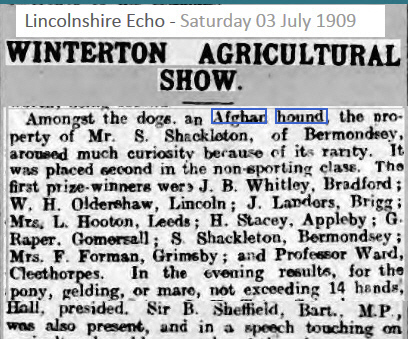 |
2 POINTS ARISING -
2.1 Ownership , (Update July 2015)
As is apparent from the press show report above, Mr Shackleton had ownership of Zardin by July 1909, so presumably Capt Barff sold Zardin to Shackleton after Crufts 1909 (Crufts is usually around February, so transfer presumably occured between February 1909 and July 1909). Mr Shackleton exhibited Zardin, not only at Crufts, but at regional all breed shows. Via the Australasian January 1908 we learn that Mrs Barff was seeking to sell Zardin as early as January 1908 because she had to return to India. This is the first suggestion that the Barffs main stock of hounds remained in India with maybe just Zardin and a couple of kennelmatres residing in England?
2.2 Offspring or puppies of the Zardin type, (Update July 2015)
Via the Australasian January 1908 we learn that Mrs Barff was seeking to sell Zardin type Afghan hounds. It would appear that the puppies were still in India as the article mentions the need for quarantine. So we are wondering if the Barffs had only Zardin and maybe a couple of other Afghan hounds in England and that the bulk of their bloodstock was in their kennels in India?
2.3. Zardins year of birth = 1902
In 1907 Mrs Barff stated she believed Zardin was approximately 5 years of age, thus suggesting he was born in 1902
2.4 Origins Of Zardin (Updated July 2015)
One of the long standing mysteries about Zardin was where was he born? The Rev H Bush (an expert on eastern/oriental hounds in this era) states Zardin came from Seistan and his information is believed to have come direct from Mrs Barff, or, her writings in the London "Field" magazine. To complicate the matter Major Bell-Murray wrote in 1926 - "I had a very large illustration of Zardin, who incidentally did not come from Afghanistan at all, but from a place called Chagai, hundreds of miles from Afghanistan in the Mekram (Persian) country". AHT believes the answer is SEISTAN and that Major Bell Murray is in error.
(We note that Major Bell Murray was in the middle of a very public argument with Mary Amps in 1926, each accusing the other of not having pure Afghan hounds. Mary Amps suggested the Bell Murray's were related to the Greyhound type found close to the Afghanistan/Persian border. , Major Bell Murray suggested the Ghazni's were similar to a poor quality shaggy hound known as the Powindah dog. Both cited Zardin as being the perfect specimen. AHT believes its pretty clear that Major Bell Murray tried to position Zardin's origins hundreds of miles away and closer to the Afghanistan/Persian border to counter Mary Amps negative comments about hounds in that region. Thus, AHT is inclined to dismiss Major Bell Murray's statement on Zardin's origins as purely political and an attempt to score points in the argument. AHT is more convinced with the narrative originating from the London "Field" (reportedly sourced from Mrs Barff, a regular correspondent for the Field magazine) and as quoted in the Australian newspaper archives above.
2.5 Afghanistan and its "different countries"
However, Major Bell-Murray makes a very interesting point with his comment "I had a very large illustration of Zardin, who incidentally did not come from Afghanistan at all, but from a place called Chagai, hundreds of miles from Afghanistan in the Mekram (Persian) country. Please see the map (map dates to the late 1880's) below, It is important to understand that Afghanistan has never been a unified country, even the Moguls never had total rule over the population, Also, the borders were constantly changing because of local/tribal fights/relationships that constantly moved the borders in/out of the different "countries". I mention the word "countries" pointedly - we westerners have a modern view of Afghanistan which we tend to view as one country. Back in the 1880's, despite the penetration into the interior by the British military, and despite a "political" definition of a single country, those on the ground knew full wel that travelling from one region to another was effectively traveling "from one country to another"
Consider again what Major Bell Murray wrote "did not come from Afghanistan at all, but from a place called Chagai". So, clearly even as late as the 1880's the boots on the ground recognized that the "country" of Afghanistan was in fact a political determination, whereas the fact was that adjacent "regions/states" were effectively "different countries". I believe that understanding Afghanistan and its regions (adjacent countries?) is helpful to understanding the possible origins of the hounds exported to the UK by the founders, such as Major Bell Murray and Major Amps..We should be aware also that Major and Mary Amps were stationed in Kabul (way up north, offf the map, I had to add Kabul to show it on this map), and Major Bell Murray was stationed in Baluchistan. Their knowledge of Afghanistan, the country, the environment, the people, the dogs, the climate etc was different. I douibt either party had a full knowledge of the wider Afghanistan and that their knowledge and experiences were limited by the boundaries of their military travel. Thus, both parties argued that their type of Afghan hound was the only correct type, and each partie correct type was only found in the region which each respective party workd/travelled/lived.
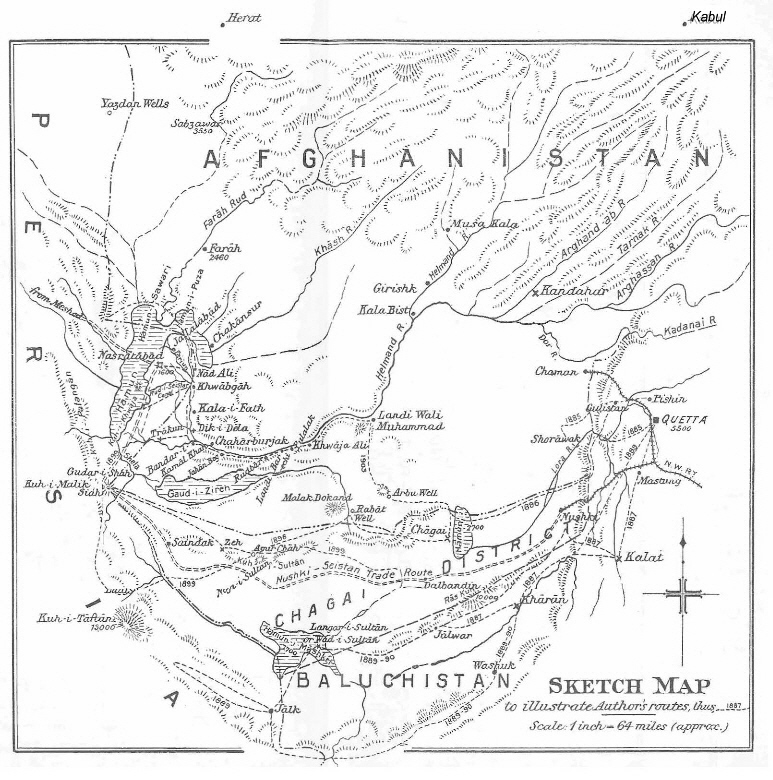 |
The above map is revealing. The map is drawn with "Afghanistan" shown in the northern half of the map. The boundary between Afghanistan and the souther regions (other countries?) appears to be the Helmund river which flows east-west (or west-east)
Where is Seistan? Look on the western side of the map for Lake Helmund, Seistan encompasses large portions of Lake Helmund. Further west, beyond Seistan is the Persian (Iran) border. Chagai (mentioned by Major Bell Murray as the place Zardin came from), is just above Baluchistan (where Major Bell Murray was based, thus convincing this cynic (Steve T) that the Major sought to relate Zardins origins to be within the region where Major Bell Murray was active, and by association with Zardin, seek to reinforce his veiw that his type came from "Zardin Country:. Let us remember that the authority on this topic (Mrs Barff) clearly stated that Zardin came from Seistan..
We should also point out on the map you will see a dotted line annotated "Nushki - Seistan Trade Route". This was the established, traditional route that traverseed the country west-east/east west, along which native caravans would travel, bringing with them all sorts of interesting things - including their hounds. The eastern end of the route is very close to Quetta the large British Military encampment at this time and military supplies for the British Military bases in Seistan would have been conveyed via the Nushki - Seistan Trade Route.
What is still a puzzle is that we have no records/reports of Captain Barff, Major Bell Murray, or Major Amps ever having travelled to Seistan. So allthough Mrs Barff informs us Zardin came from Seistan, we have no information how or where she acquired him. Did she purchase Zardin in India from an agent who bought him in from Seistan? Did she ever visit Seistan and obtain Zardin there? Sadly, with all these founders, we have very little information about exactly where their hounds came from.
Zardin sired litters in India (Cawnpoor), but what type, and from where did his breediing mate/s come from? Looking at the William Barff provided catalogue of photographs, it's almost tempting to conclude that Capt and Mrs Barff succeeded in breeding a type that possibly both Major Bell Murray and Major Amps desired to achieve (Did positioning themselves so firmly in public statements that that only their type was correct, inhibit their ability to explore and diversify their type? Cearly, if Capt Barff and Mrs Barff could breed Zardin type (and lots of hounds that are clearly of the same type) there had to be a potential for Bell Murray and Amps to follow suit (for example, they could have purchased Zardin offspring when they were in India? and bred from that stock.
It is interesting to review the two photos below. Left hand photo from the William Barff collection taken in India, right hand photo from Frank Townend Bartons book 1914 also taken in India. There are hints in the hounds in the leftt hand photo of "other types" in the kennel? Some of the hounds appear to be a bit rangier? than Zardin, a bit like some of the Bell Murrays? and with a longer/refined head compared to the Ghazni's, but having a weight of coat similar to some of the Ghazni's. Is this evidence that Capt and Mrs Barff bred their Zardin base into a variety of other types and succeeded in retaining the virtues of Zardin? We'll perhaps explore this aspect in a future article
 |
(see article updates above)
**New info 9/24/2016 - we recently found an advertisment dated December 1910 for a litter of Afghan hounds sired by Zardin. We have no further details about this litter other than the information contained in the advert.
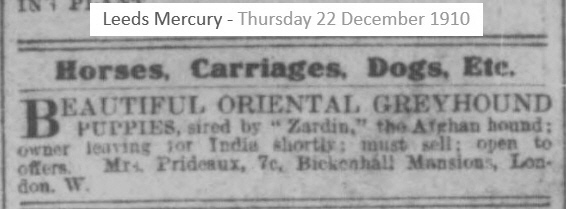 |
- 1910 ("Stranger" and "Lassie") Zardin is listed at Crufts, and ALSO listed is "Stranger" and "Lassie", also owned by Shackleton. Were these Afghan Hounds? We cannot assume that because Shackleton owned other breeds. Update 2016 - yes they were Afghan hounds, see the report on "Foreign Dog Show" (Crufts 1908) press cutting below.
- 1911 ("Afghan Lass" d.o.b 1909 or earlier) ) Zardin is listed at Crufts, and ALSO listed is "Afghan Lass", also owned by Shackleton. This time we know "Afghan Lass" was indeed an Afghan Hound because Hubbard confirms this. "He (Zardin) was painted by Mr. F.T. Daws (together with a bitch named "Afghan Lass") in 1909 and this painting is in the possession of Mrs Robson" (as of 1951 that is) . I (Steve) know that the painting was last owned as recently as the 1990's by an exhibitor/friend of mine residing in England. (As a footnote on Afghan Lass's date of birth - Lass is listed in the 1911 Crufts Catalogue, Given that Lass is a subject included in the Daws painting of 1909, clearly she must have been born in 1908 or earlier.)
- 1911 ("Moti"), possibly born 1912. Only two puppies survived (Moti and one other bitch, name unknown).
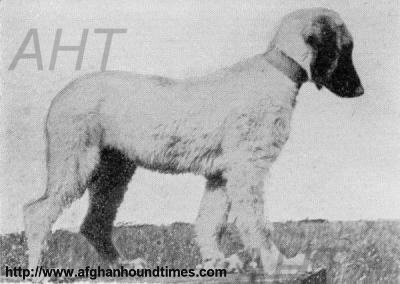 |
Quoting Doggie Hubbard again - "In a letter from Mr Hadden it appears that "Moti" suffered rather badly from a skin disease: on the outbreak of the First World War she was given by Mr Hadden to M Styles, the Birmingham breeder of Great Danes and Borzois, but after the skin trouble had broken out again she had to be painlessly destroyed. About this time all Mr Shackleton's dogs died under rather mysterious circumstances. Noting Hubbards words "about this time" ( referring to the outbrook of WWI - 1914?) do we correctly assume Zardin was owned by the Shackletons until 1914 when he presumably died under the mysterious circumstances Hubbard mentions above?
Update, since writing the above re Moti we have received the following from John Bloor, Chairman of Midland AHC (UK) and Breed Notes correspondent for "Our Dogs" newspaper (UK). - " I just came across this extract from UK Breed Notes in 1950. I'm sure you will already have this, but just in case it fills any gaps, here it is: - 23rd June, I am grateful to Mr. Norman G. Haddon for the following: “Concerning your enquiry about a son of Zardin called Moti, I may be able to help you. I had a daughter of Zardin (in I think 1912) and named her Moti. I fancy you may have seen a snapshot of her which I gave to Miss de B.-Levy. I think Moti and one sister were the only survivors of a litter bred by Mr. Shackleton (an animal dealer who acquired the hounds from Major Barff) and he sold these two to Captain Hamilton, Dublin, who was a breeder of Bulldogs and Great Danes. Moti came to me in September 1912 and was a lovely typical Afghan, but suffered from a recurrent form of skin trouble. I kept her until war broke out in 1914 and then gave her to Mr. Styles, Birmingham, who kept Danes and Borzois. He had more trouble with the skin disease and eventually had her put to sleep. About that time all Shackleton’s hounds died – said to have been poisoned. I fancy that Zardin sired very few pups in this country.
Feb 19 2018 - Another Update re Mr Hamilton. We found the news archive below dated 31st August 1912 which states that Mr Hamilton has added three Afghan hounds to his kennel. So we now have two independent newspaper accounts of a Zardin litter that whelped in the summer of 1912, Two (or three) of this litter went to Mr R A V Hamilton (Foxrock kennel), Foxrock, Hollybrook, County Dublin
 |
4. UPDATE DECEMBER 5th 2015
We mentioned Afghan Lass and Stranger above. We are excited to report that we have recently discovered a Times of London newspaper item dating from 1908 that provides more information about Afghan Lass and Stranger -
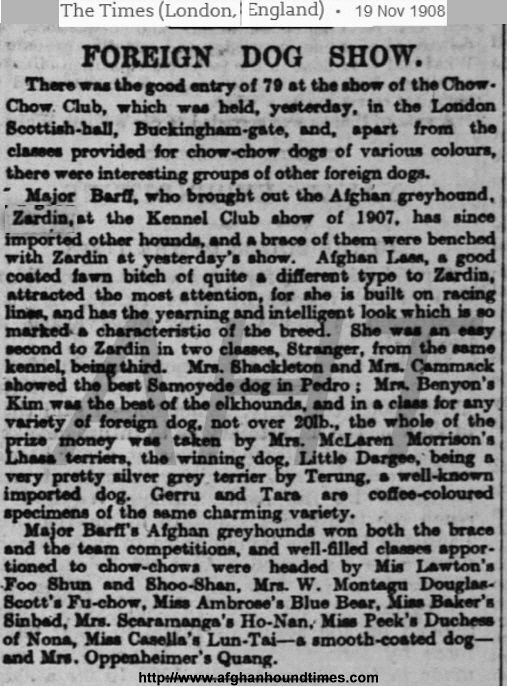 |
Afghan Hound Times,2013, 2014,2015,2016
Related content
NEW Aticle/Photos on Zardin (William Barf unseen photos)
Mr Shackleton (Zardins 2nd owner) Page
A Brief Sketch Of Afghanistan/Pakistan/India History (Author Steve Tillotson, June 2013)
1906 Indian Kennel Club Description Of Zardin
1907 Zardin meets the King and Queen of England
Press Cuttings about Zardin compiled by Steve Tillotson 2015
Afghan Lass, Barff/Shackleton
Early Afghan hound section
The F.T. Daws Painting, (Painted 1909)
NEW Articles/Photos on Zardin (William Barf unseen photos)
Library Of Articles/Main Menu Toolbar
Early Afghan Hounds
Whats New Page